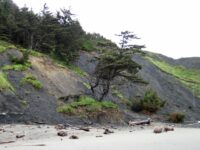Mile 20 Report
Saddle Rock, Crook Point
August 7, 2008
26 species of kelp/algae with Bryozoans, Hydrozoans and a few jellys in the driftline.
Report Details
26 species of kelp/algae with Bryozoans, Hydrozoans and a few jellys in the driftline. A Northern Elephant Seal resting on the beach and a California Sea Lion hauled up on the rocks at Crook Point headland. Harbor Porpoises and Gray Whales swimming offshore. Many Harbor Seals hauled out on the rocks. Brown Pelicans on rocks and in bay with Herrmann's Gulls, Western Grebes, and cormorants. Western Gulls, Black Oystercatchers, Pigeon Guillimont, and Caspian Terns flying over ocean and on off-shore rocks. California and Steller's Sea Lions on off-shore rocks. Nereocystis (Bull Kelp) and Cystoseira (Northern Bladder Chain) in kelp beds in bay. Otter, deer and raccoon tracks on beach. Dead Townsend's Vole on beach. Sand moving onshore and accumulating next to driftwood. Some patches of cobbles. Beach slope of 6 degrees. Air and ocean temperature of 60 and 54.3 degrees F., respectively. Low human impact (0).
Conditions
Temperature: 60 F. Cloud Cover: Cloudy. Wind Velocity: Calm/Light. Wind Direction: N.
Notable Wildlife
Four Harbor Porpoise, and several Gray Whales in near shore ocean. Many Harbor Seals hauled out on offshore rocks. Numerous Brown Pelicans on rocks and in bay with Heermann's Gulls, Western Gulls, Black Oystercatchers, Pigeon Guillemot,cormorants, California Sea Lions, and Stellers Sea Lions on offshore rocks. Nereocystis (Bull Kelp) and Cystoseira (Northern Bladder Chain) in kelp fields of the bay. Otter, deer, and raccoon tracks on beach. One resting Northern Elephant Seal on the beach. One dead Townsend's Vole (Microtus townsendii), and one large live beetle,a Ten-lined June Beetle (Polyphylla decemlineata) on the beach.
Stranded Marine Mammals
Total stranded mammals: 2. 1 Living and resting Northern Elephant Seal, 1 living California Sea Lion that was hauled out on the rocks below Crook Point.
Dead Fish or Invertebrates
A few Red-eye Medusa (Polyorchis pencillatus) and Lion's Head Jelly (Cyanea capillata) on the beach. Lots of burrows of the California Beach Hopper (Megalorchestia californiana) were very visible due to the darker sand that was thrown on top of the lighter sand (see photos). Both Red-rock Crab (Cancer productus) and Spotted-belly Crab (Cancer antennarius) carapaces were on the beach. Other invertebrates included large Leather Bryozoan (Flustrellidra), and Hydrozoans.
Driftline Content
Seaweeds and seagrass, Animal casings (e.g., crab, shrimp molt), Animal casings (e.g., crab, shrimp molt), Ocean-based debris (from fishing boats, ship trash, etc.). Flustrellidra (Leather Bryozoan), Hydrozoa, Red-eye Medusa (Polyorchis pencillatus), and Lion's Head Jelly (Cyanea capillata).
Man-made Modifications
see General Comment
Actions & Comments
Reported both Northern Elephant Seal and the California Sea Lion to Jim Rice, Marine Mammal Stranding Coordinator and to David Ledig, USFW manager for Crook Point Refuge.Twenty-six species of kelp/algae were in the driftline. These included the following: Ahnfeltiopsis (Flat-tipped Forked Seaweed), Laminaria sinclairii (Dense-clumped Kelp),Hymenena (Black-lined Red Seaweed), Cystoseira (Northern Bladder Chain), Cryptopleura (Ruffled Red Seaweed), Mazzaella (Iridescent Seaweed), Desmarestia ligulata (Acid Kelp or Broad Acid Weed), Fucus (Rockweed), Plocamium (Sea Braid), Neorhodomela (Black Larch), Pelvetiopsis limitata (Little Rockweed), Ulva (Sea Lettuce), Pleurophycus (Broad-rib Kelp), Porphyra (Nori or Laver), Mastocarpus papillatus (Turkish Washcloth), Postelsia palmaeformis (Sea Palm), Callophyllis (Beautiful Leaf Seaweed), Ptilota (Sea Fern), Egregia (Feather Boa Kelp), Pterygophora (Old Growth Kelp), Alaria (Ribbon Kelp), Saccharina (Sea Cabbage), Chondracanthus (Turkish Towel), Prionitis (Bleach Weed), Erythrophyllum (Red Sea Leaf), and Dilsea California (Leathery Strap Seaweed). The aquatic angiosperms, Eelgrass (Zostera) and Surfgrass (Phyllospadix) were also in the driftline.Beach modifications: Sand of south beach moving on shore covering rocks and piling up against the drift logs. Beach slope 6 degrees. Middle beach with five cobble patches.


















Report Images
All Mile 20 Reports
Mile 20
Saddle Rock, Crook Point
One person and two dogs were seen on the beach.
D Bilderback
Mile 20
Saddle Rock, Crook Point
Except for one small heavy patch of drift, the driftline was sparse with kelp/algae, Leather Bryozoa and crab carapaces.
D Bilderback
Mile 20
Saddle Rock, Crook Point
The driftline was absent except for two localized areas with terrestrial-derived leaves, mosses, wood pieces, some shredded blades of Pterygophora(Old Growth Kelp) and a few invertebrates and other algae and kelp.
D Bilderback
Mile 20
Saddle Rock, Crook Point
Peregrine Falcon resting on south end of Saddle Rock.
D Bilderback
Mile 20
Saddle Rock, Crook Point
Light driftline with 12 different genera of kelp and algae, terrestrial mosses, Leather Bryozoa (Flustrellidra corniculata), the flowering plant, Phyllospadix (Seagrass) and small rocks.
D Bilderback
Mile 20
Saddle Rock, Crook Point
Three boats seen drifting very close to offshore rocks.
D Bilderback
Mile 20
Saddle Rock, Crook Point
The south beach lacked driftline and sand has accumulated around the drift logs and over the large rocks at the base of the headland.
D Bilderback
Mile 20
Saddle Rock, Crook Point
The driftline was light on the southern and northern portions of the beach but heavy on the middle portion of the beach with large amounts of kelp/algae and forest duff.
D Bilderback








